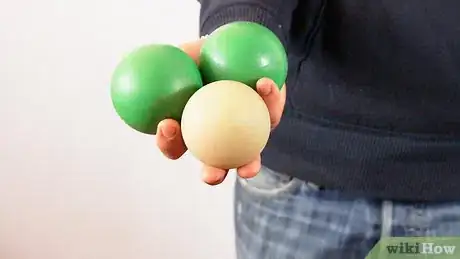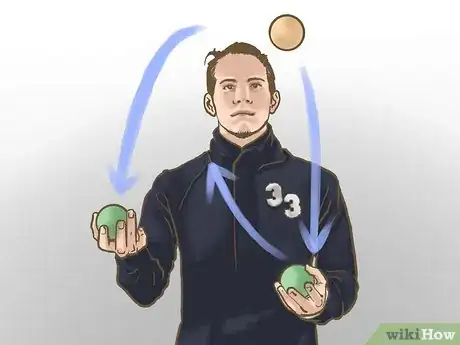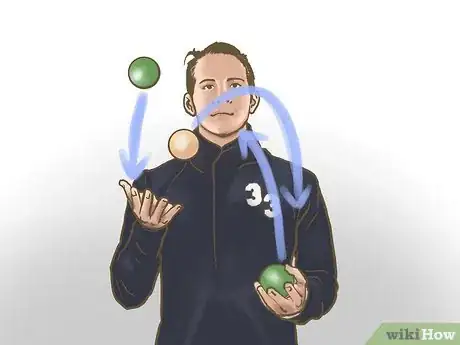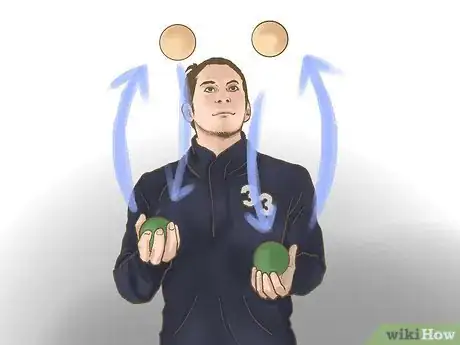wikiHow is a “wiki,” similar to Wikipedia, which means that many of our articles are co-written by multiple authors. To create this article, 115 people, some anonymous, worked to edit and improve it over time.
There are 8 references cited in this article, which can be found at the bottom of the page.
This article has been viewed 1,186,444 times.
Learn more...
Juggling is a fun and rewarding hobby that’s even more entertaining to perform than it is to watch. Plus, studies show that people who learn to juggle can increase their brains' gray matter![1] If you’ve always wanted to juggle but struggled to master the right technique, you’ve come to the right place. While juggling may seem difficult at first, it’s easy once you know what to practice. This article will walk you through the basics of juggling so you’re comfortable tossing and catching at least 2 balls. Then, we’ll show you how to add a 3rd…a 4th…even a 5th. Keep reading and you’ll be able to juggle almost half a dozen balls in no time!
Things You Should Know
- Start by tossing 1 ball from 1 hand to the other, attempting to get it about eye-level near your opposite shoulder with every toss.
- Try and aim your ball so it falls right into the opposite hand. The less you have to reach to catch each ball, the easier juggling will be.
- Add 2 or more balls by tossing each ball at the exact moment the 1st ball reaches its peak from your opposite hand.
Steps
Juggling Basics
-
1Choose non-bouncy balls to practice with. Don’t waste your precious practice time running back and forth to get rollaway balls. Find objects that have the same weight and shape as a ball, but won’t bounce or travel easily if they're dropped. Consider buying some beanbags or making tennis balls easier to juggle by filling them with sand and coins, then covering them with a round balloon.[2]
- You can also stand in front of a wall to stop balls from going too far forward.
- Try to not add too much weight to your practice balls. Dropping heavy objects may damage your floor or hurt your toes.
- Also, choose a suitable place to work in. At the beginning of your juggling career, you’ll have balls flying everywhere, so it's best not to stand near granny's precious oil lamp or dad's collection of ceramic cows.
-
2Toss 1 ball for a while to get the feel of juggling. Pass your ball or bean bag from one hand to the other a few dozen times. Aim to get the ball to about eye-height near the opposite shoulder with every toss. Also practice "selfies" (throws you catch with your throwing hand).[3]
- Keep your elbows at your hips and avoid moving your hands as much as possible. Otherwise, your tosses will be too all over the place to keep a juggling rhythm.
- For extra practice, snap your fingers every time the ball reaches peak height. This will help you get used to the timing of when to toss the next ball.
- Keep your tosses high and narrow, instead of short and wide. The balls are easier to control when they’re thrown higher!
Advertisement -
3Practice “scooping.” Make your juggling motions smoother by “scooping,” or dipping your hands right before you release the ball. Keep your dips shallow, so you don’t launch the ball too far, and ensure that the arc of your scoops doesn’t rise above eye level.[4]
- If “scooping” feels unnatural to you, try getting rid of the balls and mimicking just the movements of juggling. When you "air juggle," you’ll often find yourself moving your hands in small circles. This is scooping!
-
4Start tossing another ball. Once you’ve gotten the hang of scooping and tossing 1 ball between each hand, you’re ready to start juggling 2. Toss your first ball. Then, when it reaches the top of its arc, toss the 2nd ball. Practice until this simple exchange becomes comfortable.[5]
- Tossing at the top is key here. This will give you the most time for your next catch. When you start working with 3, 4, and 5 balls, timing each toss like this becomes especially important.
- Don’t worry about catching both balls at first. It’s okay if they fall; just focus on hand position and timing. Once having 2 balls in the air becomes comfortable, you can focus on catching.
- Try to toss both balls to the exact same height and aim them so they’ll fall comfortably into the opposite hand. The less you have to move your hands to grab them, the easier catching them will be. Once you can catch and throw effectively, juggling 2 balls is just a matter of repeating this process over and over.
- If you're having trouble throwing a ball the other hand accurately or with consistent height, try to visualize a box from your elbow height to about a foot above your head. Aim for the corner of that box.
Juggling 3–5 Balls
-
1Try to make 3 passes in a row. Once you’re able to toss and catch 2 balls 15-20 times in a row, try juggling a 3rd. Start out slowly to see how the 3 balls work together in the air during each rotation. Juggling 3 balls is often a matter of understanding the balls' trajectories and how they intertwine. For the majority of the time, 1 ball will be in the air while you hold the other 2 in each hand:[6]
- First, hold 2 balls in your right hand and 1 in your left hand (vice versa if you’re left handed).
- Begin by tossing a ball from your right hand (again, vice versa if you’re left-handed).
- Throw the ball to your left hand and when ball 1 is at the peak, throw ball 2 (the only one in your left hand) under ball 1 to your right hand.
- Catch ball 1 before ball 2 reaches its peak.
- When ball 2 is at the highest point, throw ball 3 under ball 2.
- Catch ball 2 before ball 3 reaches its peak. Then, toss ball 1 when ball 3 reaches its highest point and repeat. This technique is called the “3 Ball Cascade.”
- If you can't seem to get the hang of it, try working with light, small scarves instead of balls. They'll spend more time in the air which will help you understand how it all comes together.
- Juggling can be frustrating. Remember to relax, breathe, and take a break if needed. It may take days before you're able to juggle 3 balls multiple times in a row.
-
2Work on the over-the-top method. Once you’ve got the simple 3 Ball Cascade down, start juggling "over the top" to add some style and flair to your throws. To juggle over-the-top:[7]
- Select a ball you wish to toss over the other 2 (hence the name over-the-top). Ideally, this ball will be a different color so it’s easy to identify.
- Then, each time your selected ball is caught in your dominant hand, scoop that dominant hand in the opposite direction (away from you) and hook the selected ball over the other 2.
- Once you’ve hooked the ball over with your dominant hand a few times, repeat the same motions with your other hand.
- Tossing 2 balls in a normal 3 Ball Cascade pattern with 1 ball over-the-top is called a "Slow Shower." If every ball you juggle is an over-the-top-throw, it’s called a “Reverse 3 Ball Cascade.”[8]
- Once you’ve mastered the over-the-top method, you can advance to more complex juggling techniques like cross-hand juggling, columns (1 in the middle, 2 on the sides), and "Mills' Mess" (crossing your arms and throwing the same ball underarm each time).
-
3Add a 4th and 5th ball to your rotation. Once you’ve mastered multiple methods for 3 balls, start juggling 4 by learning to juggle 2 balls in 1 hand. Toss a new ball at the previous ball’s peak, scoop before each throw, and keep your hand in constant motion so you can catch both balls and they don’t collide in mid-air. Once you can juggle one-handed with both hands, simply alternate hands to juggle 4 balls simultaneously.[9]
- Once you’ve mastered a 4-ball pattern, try adding a 5th ball. Juggling 5 balls is just like juggling 3, but you have to move your hands a lot faster and you need to throw the balls higher. Keep practicing and don’t give up –– juggling takes time and patience to master.
- You can also use the 3 Ball Cascade pattern to juggle 4 balls. Incorporate a horizontal pass into this technique to make adding a 5th ball easier.
Community Q&A
-
QuestionHow high can I juggle?
 wikiHow Staff EditorThis answer was written by one of our trained team of researchers who validated it for accuracy and comprehensiveness.
wikiHow Staff EditorThis answer was written by one of our trained team of researchers who validated it for accuracy and comprehensiveness.
Staff Answer wikiHow Staff EditorStaff AnswerToss the ball high, but not too high. Generally, eye-height is the best way to give your balls some leverage while still keeping them under control.
wikiHow Staff EditorStaff AnswerToss the ball high, but not too high. Generally, eye-height is the best way to give your balls some leverage while still keeping them under control. -
QuestionCan you juggle with other objects like pens or pencils?
 wikiHow Staff EditorThis answer was written by one of our trained team of researchers who validated it for accuracy and comprehensiveness.
wikiHow Staff EditorThis answer was written by one of our trained team of researchers who validated it for accuracy and comprehensiveness.
Staff Answer wikiHow Staff EditorStaff AnswerYou can absolutely juggle with other objects, but avoid pencils are other sharp materials so you don't hurt yourself. In addition, it may take some getting used to as the weight distribution for other objects will be different from balls.
wikiHow Staff EditorStaff AnswerYou can absolutely juggle with other objects, but avoid pencils are other sharp materials so you don't hurt yourself. In addition, it may take some getting used to as the weight distribution for other objects will be different from balls. -
QuestionIs learning juggling worth it?
 wikiHow Staff EditorThis answer was written by one of our trained team of researchers who validated it for accuracy and comprehensiveness.
wikiHow Staff EditorThis answer was written by one of our trained team of researchers who validated it for accuracy and comprehensiveness.
Staff Answer wikiHow Staff EditorStaff AnswerAbsolutely! Juggling is a hobby that you can pull out at parties tomorrow or 20 years down the line. Plus, once you get the hang of it, it's a great way to keep your hands occupied while you think.
wikiHow Staff EditorStaff AnswerAbsolutely! Juggling is a hobby that you can pull out at parties tomorrow or 20 years down the line. Plus, once you get the hang of it, it's a great way to keep your hands occupied while you think.
Warnings
- Do not attempt to juggle any sharp or dangerous objects. Only professionals know how to do this.⧼thumbs_response⧽
- Juggling is an exercise; try to "warm up" with stretching exercises before a juggling session.⧼thumbs_response⧽
References
- ↑ http://abcnews.go.com/Health/Technology/story?id=116656&page=1#.T7A6k7-XdgI
- ↑ https://pubmed.ncbi.nlm.nih.gov/3217207/
- ↑ https://youtu.be/BaXWuA_mxe0?t=81
- ↑ http://www.jugglingpoet.com/crju/jugthree.html
- ↑ http://www.juggling.org/help/rings/starting.html
- ↑ https://libraryofjuggling.com/Tricks/3balltricks/Cascade.html
- ↑ http://www.funnyjuggler.com/juggling/?LessonID=12
- ↑ http://www.jugglingworld.biz/tricks/juggling-tricks/3-ball-juggling-tricks-page/
- ↑ http://www.jugglingpoet.com/crju/jugfour.html
About This Article
If you want to learn to juggle, practice with beanbags or balls that don’t bounce or roll much when you drop them. Pass a ball from one hand to the other, then toss the ball up to about eye level and catch it with your throwing hand. Drop your hand slightly before you throw the ball, called scooping, to keep the movement smooth. Once you get comfortable tossing one ball, add in another. Alternate tossing each ball when the other is at the top of its arc, which will give you time for a smooth catch. Gradually add more balls, tossing them with alternating hands. If you want to learn how to juggle 3 or more balls at the same time, keep reading the article!




























































